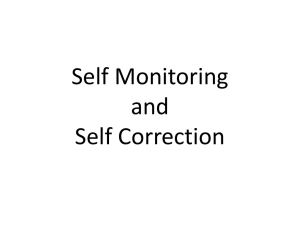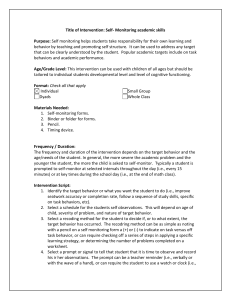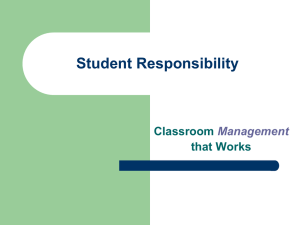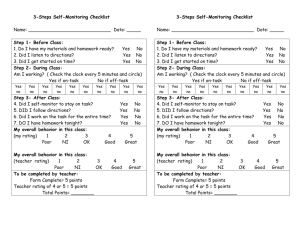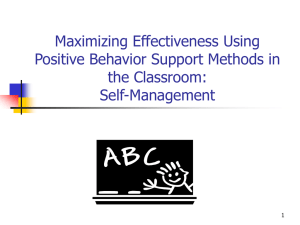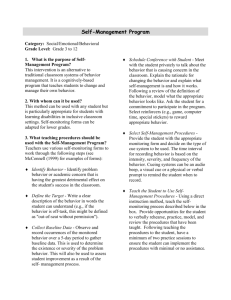1H_Selfmonitoring13 - Missouri Schoolwide Positive Behavior
advertisement
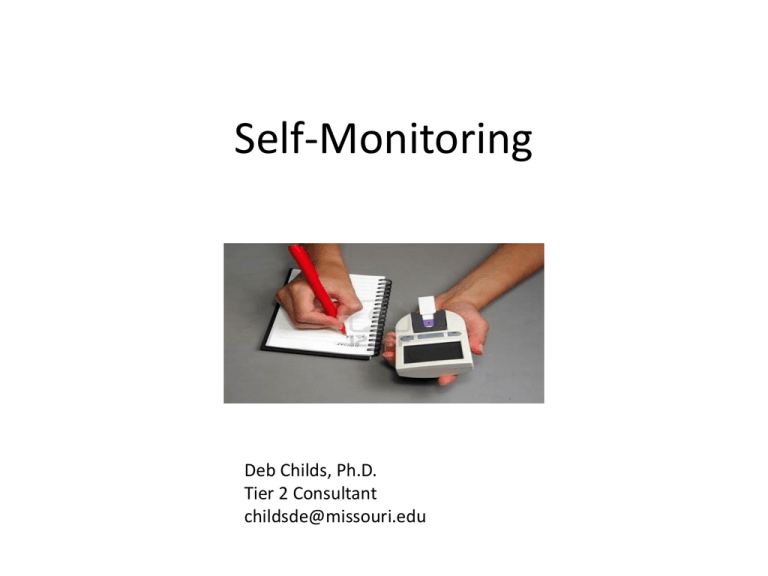
Self-Monitoring Deb Childs, Ph.D. Tier 2 Consultant childsde@missouri.edu Session Overview • • • • • • What is self-monitoring? What does the research tell us? Steps for implementing self-monitoring Self-monitoring as a classroom support Self-monitoring as a Tier 2 intervention Self-monitoring as a fading procedure for a Tier 2 intervention Self-Monitoring Interventions Student self-observes and self-records target behavior Goal Setting Interventions Student creates behavior targets (goals) SelfManagement Strategies Self-Evaluation Interventions Student assesses behavior against a set standard Self-Instruction Interventions Student uses self-statements to direct behavior Strategy Instruction Interventions Student follows a series of steps to complete a task autonomously What is Self-Monitoring? A process of self-observation and recording of a skill. • Student must be able to discriminate the occurrence of the behavior • Student must have the skill in their repertoire What does the Research Tell Us? • Effective for ALL students K-adult (Jolivette & Ramsey, 2006) • Is effective as a classroom system of behavior management (Carr & Punzo, 1993) • May be used with academic and behavior skills (Shapiro & Cole, 1994) What does the Research Tell Us? • Is less invasive than teacher managed strategies (Fantuzzo, Polite, Cook, & Quinn, 1988) • May be more effective than teacher managed strategies for some students (Shapiro, DuPaul & Bradley-Klug, 1998) What does the Research Tell Us? • Contributes to the acquisition of selfregulation which is the crossover skill between academics and behavior (Wery & Nietfeld, 2010) Steps for Implementing Self-Monitoring 1. 2. 3. 4. 5. 6. 7. Identify target behavior Define the target behavior Collect baseline data Design procedure and materials Teach student to self monitor Monitor progress Follow up and fade Self-monitoring as a Classroom Intervention • Discuss goal setting with class • Each student chooses a skill or behavior to improve (may need coaching from teacher) • Skill is defined and written in positive terms • Collect and chart baseline if available • Set goals • Determine when and where skill will be monitored and chart to be used to keep data • Teach how to self-monitor (check for agreement) • Follow up 1. Identify Target Behavior • State in positive terms – What do you want the student to do? • Consider where and when the behavior occurs – This will help determine the location or type of activity to monitor Activity • Think about a skill or activity you would like to improve • Write it on a piece of paper • If you feel comfortable, share it with an elbow partner 2. Define the Target Behavior • Use the OMPUA guidelines to help you – Observable, measureable, positively stated, understandable, always applicable • The skill must be in the student’s repertoire – Self-monitoring is used for performance deficits not acquisition deficits. • Include any steps associated with the skill Examples of defined target behavior • Respect others = Use good words, keep hands and feet to self, ask to use others’ belongings • Be responsible = Go to class on time, bring needed items, put your things away when done • Follow directions = Listen to what you are being asked to do, ask questions if you need to, begin the task Examples of defined academic skills • Be able to recite/write times tables 1 – 10 by Jan. 15th • Read 5 books a week at the 3.0 level or above and complete comprehension questions at 80% or above. • Complete all homework to 80% criteria Activity • Write your target behavior using OMPUA guidelines • List any steps associated with your target • If you feel comfortable, share it with an elbow partner 3. Collect Baseline Data How often does the target behavior occur: • Frequency counts – record each time behavior occurs or look at permanent products • Time sampling – observing the occurrence or non-occurrence of the target behavior during a fixed amount of time • 3-5 data points • Graph analysis for visual evaluation. Baseline warnings • Look for the easiest and least time consuming way to determine approximate frequency of behavior. • Do not have student collect their own baseline • If you or a peer collect baseline, target student should not be aware it is being collected. • Do you have past records associated with your skill that allows you to collect baseline? 4. Design Procedure and Materials • Determine when the students will selfmonitor. – How will students be cued to do so? • Create self-monitoring chart. – Should be age appropriate – List the target behavior and any steps needed to complete the skill – Have an area to write goal Self monitoring chart samples Self-Monitoring Daily Progress Report Date ________________ Student Name ______________________ Tasks Completed Monday Reading Math Social Studies Science Ck Tasks Completed Tuesday Ck Tasks Completed Ck Wed Out of Out of Out of Out of Out of Out of Out of Out of Out of Out of Out of Out of Total for the day ____/_____ Tasks Completed Thursday Ck Tasks Completed Friday Out of Out of Out of Out of Out of Out of Out of Out of Goal ___________________ Parent/Guardian Signature ___________________________ I’m proud of you today because __________________________________________ Ck Writing Assignment Checklist Place a check next to the items completed. Name______________________ Class____________ Date__________ All sentences begin with a capital letter. All sentences have correct punctuation at the end. All sentences have a subject and a verb (are complete sentences) The first word of the paragraph is indented The paragraph has a topic sentence All sentences in the paragraph are on the same topic I followed instructions for the assignment I completed all parts of the assignment The goal for this writing assignment is_________ Tier 2/Self-Monitoring Daily Progress Report Student Name ______________________ Date ________________ 3 = 0-1 reminder Be Safe 2 = 2 reminders 1 = 3+ reminders Be Respectful Keep hands & feet Teacher Follow directions Teacher Check to self check 8:30 to Morning Break Morning Break to Lunch Lunch to Afternoon Break Afternoon Break to Dismissal Be Responsible Use materials appropriately 3 2 1 3 2 1 3 2 1 3 2 1 3 2 1 3 2 1 3 2 1 3 2 1 3 2 1 3 2 1 3 2 1 3 2 1 Total for the day _________________/36 Parent/Guardian Signature ___________________________ I’m proud of you today because __________________________________________ Teacher Check Activity • How often will you monitor your skill? • Design a simple chart you would use to monitor. Make sure it lists needed steps. • Determine a goal • Share with an elbow partner 5. Teach Students to Self-Monitor • Discuss with individual students their target skill or have students discuss in pairs • Allow students to set goals – refer back to first lesson on goal setting • Create cueing system if needed • Allow time at the end of the designated period for completing chart and graphing results Deb Childs Activity • What will you use to remind yourself to selfmonitor? – Phone alarm? – Friend? – Spouse? – Sticky note on mirror? Deb Childs 6. Monitor Progress • Positive feedback given for student accurately assessing and recording until teacher and student agree at least 80% of the time – May use peers to check accuracy • Teacher/peer check of accuracy is faded to periodic checks (1/5 average) • Adult provides specific verbal feedback when target skill is displayed. Activity • How often will you review your progress? Deb Childs 7. Follow up and Fade • Reteach or review skills as needed • Review progress and celebrate success – Having student graph progress allows for quick visual evaluation and may increase student rate of improvement (Harris, Graham, Reid, McElroy, & Hamby, 1994) • When student is consistently using skill and attaining goal, reduce the times per week that student monitors • Periodically check for maintenance Activity • What reinforcement or rewards will you give yourself for attaining goal? Deb Childs Self-monitoring as a Class-wide Intervention • Same steps • Target skill is the same for all students • Each student contributes to attaining goal Deb Childs 1. Identify Target Behavior • If applied to the whole class, how would you determine target? – Records of minor discipline problems – Informal observations – Student suggestion box or class meetings – Goals of curriculum Deb Childs 2. Define the Target Skill • Discuss with the entire class the importance of the skill • Examples and Non-examples Deb Childs 3. Collect Baseline • Have baseline on target skill collected and graphed • Share with class current level of skill Deb Childs 4. Design Procedures and Materials • Create chart or graph • Determine time frame for data to be collected • Determine which students will be in charge of charting or graphing skill • Determine cueing system or when students will complete chart • Set goal Deb Childs 5. Teach Students to Self-monitor • Check chosen students’ accuracy of completing chart • Reinforce for accuracy even if students did not meet goal • Fade checks as soon as students are consistently accurate Deb Childs 6. Monitor Progress • Check chart regularly for reinforcement and goal adjusting • Reteach as needed Deb Childs 7. Follow-up and Fade • When goal is met for 4 consecutive weeks begin fading frequency of checks • When goal is met for 4 consecutive weeks consider changing to a new behavior Deb Childs Class-wide Example 7th grade class was consistently late to class: 1. Gathered baseline (67% on time) 2. Defined “on time” and discussed importance of skill and barriers to attaining. 3. Assigned 2 students to monitor class progress and set goal of 80% average for the week 4. Reinforced when goal attained and goal was increased until class was consistently at 99% Self-Monitoring as a Tier 2 Intervention 1. Data is used to determine common skill deficits of students needing Tier 2 interventions. 2. Skill is defined and any steps are listed 3. Procedures and materials are designed – Monitoring form is created targeting replacement behavior (taken from matrix) – Time frame and cueing procedures determined Activity • Discuss with those at your table: – Most common problem behavior according to your most recent Big 5 Report. – What is the replacement behavior taught? – Can you name students in your building that display the problem behavior regularly? – Where is the behavior usually occurring? Monitoring Form Example Name__________________ Goal______________________________________________ Respect others by: 1. Using kind words 2. Keep hands and feet to self 3. Ask to use their things 3 – I followed all steps with 0 or 1 reminder, 2- I followed all steps with 2 reminders, 1 – I needed multiple reminders or did not demonstrat Monday Tuesday Wednesday Thursday Friday Period 1 3 2 1 3 1 3 2 1 3 1 3 2 Period 2 3 3 3 3 3 2 2 2 2 2 1 1 1 1 1 3 2 1 3 2 1 3 2 1 3 2 1 3 2 1 3 3 3 3 3 2 2 2 2 2 1 1 1 1 1 3 2 1 3 2 1 3 2 1 3 2 1 3 2 1 3 3 3 3 3 2 1 2 1 2 1 2 1 2 1 Period 3 Period 4 Period 5 Period 6 2 2 1 Self-Monitoring as a Tier 2 Intervention 4. Students are taught process for selfmonitoring and target skill(s) are reviewed. Could be done as a group review Skill should have been taught as part of matrix 5. Staff is taught to check and reinforce initial accuracy of student self-monitoring. What is your process for informing and training staff concerning tier 2 interventions? Discussion Activity • Who in your building would be available to train a group of students? (about 30 min) • Who would train staff on how to check student accuracy and how to fade those checks? Self-Monitoring as a Tier 2 Intervention 6. Student progress is reviewed and feedback given on a regular basis – Students graph results – Goal should be set and increased as appropriate – Reinforcement for goal attainment by an adult if attention maintained or student is taught to self reinforce. 7. Intervention is faded once final goal is attained – Don’t forget to celebrate Celebrate Decision Making Activity • Who would be responsible for collecting student data? • Who would be responsible for reinforcing students for attaining goal? • How long would a student self-monitor and attain target goal before the intervention would be faded? Tier 2 Intervention Example 1. Data indicate students at risk are having problems with following directions and staying on task 2. Behaviors defined: – Following directions = Listen to the direction, ask questions if needed, do what is asked – Staying on task = Look at teacher if instructing, stay in area, do your work 3. Collect baseline – teacher completes self monitoring chart for 1 week Tier 2 sample chart Tier 2 Intervention Example 4. Location, time, and cueing procedure determined 5. Student is trained in self-monitoring and skills reviewed 6. Teacher checks accuracy of student selfmonitoring until 80% and then slowly fades support. Data is collected 7. Teacher periodically checks accuracy and intervention is faded. Self-monitoring as a Modification of CICO • Student checks in at beginning of day and receives CICO monitoring form with school expectations • Student completes rating of behavior at the end of each period with teacher checking until they agree 80% of the time • Student completes rating of behavior at the end of each period with teacher fading checks until random and around 1/5. • Student checks out at end of day Self-monitoring as a modification of CICO • Student is reinforced for attaining goal according to function of behavior • This modification is not designed for attention seeking students Self-monitoring as a modification of CICO Be Safe Keep hands & feet to self Be Respectful Teacher check Follow directions Be Responsible Teacher Check Use materials appropriately 8:30 to Morning Break 3 2 1 3 2 1 3 2 1 Morning Break to Lunch 3 2 1 3 2 1 3 2 1 Lunch to Afternoon Break 3 2 1 3 2 1 3 2 1 Afternoon Break to Dismissal 3 2 1 3 2 1 3 2 1 Teacher Check Self-monitoring to Generalize Small Group Social Skills • Students are taught social skills as part of small group social skills (SGSS) • Skills completed are listed (with steps) on monitoring form • Student completes form with teacher checks • Teacher fades checks until average 1/5 • Monitoring form is turned in to SGSS instructor for reinforcement Self-monitoring Social Skills Targeted Skills Monday Teacher check Tuesday Teacher check Wednesday Teacher check Thursday Teacher check Friday Teacher check Use nice words 3 2 1 3 2 1 3 2 1 3 2 1 3 2 1 Share 3 2 1 3 2 1 3 2 1 3 2 1 3 2 1 Take Turns 3 2 1 3 2 1 3 2 1 3 2 1 3 2 1 Ask to use other’s things 3 2 1 3 2 1 3 2 1 3 2 1 3 2 1 Stay calm if you disagree 3 2 1 3 2 1 3 2 1 3 2 1 3 2 1 Total Daily Points Total Possible Daily Self-Monitoring as a Fading Procedure 1. Used when student has attained final goal on a Tier 2 intervention for a minimum of 4 weeks 2. Use same form as used for daily progress (DPR) but ask student to complete with teacher checking for accuracy 3. Once student is accurately monitoring at least 80% of the time slowly reduce the frequency of teacher checks. 4. Continue progress monitoring and adjust support as needed. Fading Example • Check in Check out – Instead of teacher completing DPR at designated times, student is asked to complete and teacher indicates agreement. – Teacher feedback is slowly faded until student is independently completing DPR – Data is kept based on student completion of DPR – Teacher periodically checks accuracy Fading Example First Phase = Student Learns to Self-Assess – – – – – – Teacher & student rate student’s behavior simultaneously Compare ratings at end of each class period Success = match in ratings (even if low rating) If discrepancy in score, discuss Teacher rating assumed accurate Provide reinforcer for accuracy & honesty (SW ticket) *Goal is for student rating to get closer to teacher rating until student is reliable and accurate in rating own behavior (80-85% agreement between teacher & student) Fading Example Second Phase = Teacher Rating Removed • Begins once student demonstrates consistency in accurately rating own behavior • Gradually remove teacher rating component – Week 1 = teacher rates 4 out of 5 days – Week 2 = teacher rates 3 out of 5 days *On days when teacher does not rate, student ratings are used for data collection and progress monitoring Fading Example • Check-in/Check-out continues throughout self monitoring process – Teacher DPR ratings are used on teacher rating days – Student DPR ratings are used on student rating days • Coordinator collects, enters and analyzes data • Data collection is critical! • If behavior deteriorates, it may be too early to remove student Fade Out of CICO Westview Elementary School Excelsior Springs School District Phase 1: Teacher and student score together Compare ratings at the end of each class period match=success, discrepancy=discussion and teacher’s rating assumed accurate Provide reinforcement for accuracy and honesty Check after 2 weeks Success to move to Phase 2 2 weeks of 80-85% agreement and Student data is at or above goal line Phase 2: Teacher fades, student begins self-monitoring Week 1-Teacher rates 4 out of 5 days Week 2-Teacher rates 3 out of 5 days Week 3-Teacher rates 2 out of 5 days Week 4- Teacher rates 1 out of 5 days Week 5- Teacher rates 0 out of 5 days Success to move to Phase 3 Student data stays at or above goal line Phase 3: Graduation Weekly alumni check-out Westview Elementary and Winfield Primary Fading Examples Self-Monitoring • May be used in your classroom with each student working on an individual skill • May be used class-wide – all students working on the same skill • As a Tier 2 Intervention • As a modification to CICO • To help generalize Social Skills • As a fading procedure for a Tier 2 Intervention Deb Childs Contact Information Deb Childs Ph.D. Tier 2/3 Consultant SWPBS • • • • • • • • References Jolivette, K., & Ramsey, M. (2006). Students with emotional and behavioral disorders can manage their own behavior. Teaching Exceptional Children, 39(2), 14-21. Carr, S., & Punzo, R., (1993). The effects of self-monitoring of academic accuracy and productivity n the performance of students with behavioral disorder. Behavioral Disorders, 18(4), 241-250. Shapiro, E., & Cole, C. L., (1994). Behavior change in the Classroom. New York, NY: Guilford Press. Fantuzzo, J.W., Polite, K., Cook, D. M., & Quinn, G. (1988). An evaluation of the effectiveness of teacher- vs. student-managed interventions with elementary school students. Psychology in the Schools, 25, 154-163. Shapiro, E., DuPaul, G., & Bradley-Klug, K., (1998). Self-management as a strategy to improve the classroom behavior of adolescents with ADHD. Journal of Learning disabilities, 31(6), 545-556 Wery, J., & Nietfeld,J. (2010). Supporting self-regulated learning with exceptional children. Teaching Exceptional Children 42(4), 70-78. Rafferty, L. (2010) Step-by-step: Teaching students to self-monitor. Teaching Exceptional Children, 41(2), 50-58 Harrris, K. R., Graham, S., Reid, R., McElroy, K., & Hamby, R. S. (1994). Self-monitoring of attention versus self-monitoring of performance: Replication and cross-task comparison studies. Learning Disability Quarterly, 17, 121-139. Deb Childs
